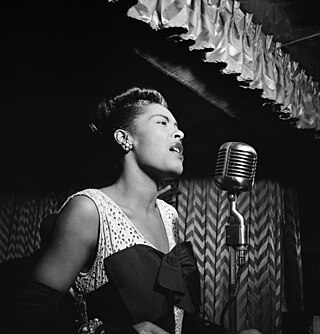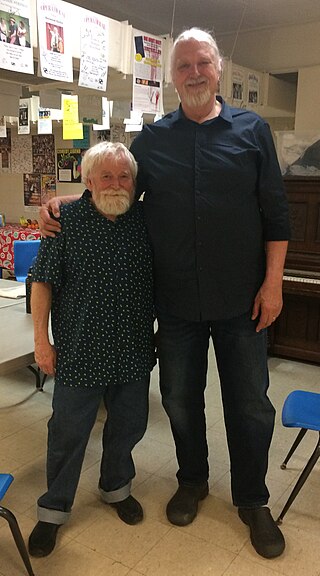Related Research Articles

A song is a musical composition performed by the human voice. The voice often carries the melody using patterns of sound and silence. Songs have a structure to them, such as the common ABA form, and are usually made of sections that are repeated or performed with variation later. A song without instruments is said to be a cappella.

The music of Australia has an extensive history made of music societies. Indigenous Australian music forms a significant part of the unique heritage of a 40,000- to 60,000-year history which produced the iconic didgeridoo. Contemporary fusions of indigenous and Western styles are exemplified in the works of Yothu Yindi, No Fixed Address, Geoffrey Gurrumul Yunupingu and Christine Anu, and mark distinctly Australian contributions to world music.
"The Big Rock Candy Mountains", first recorded and copyrighted by Harry McClintock in 1928, is a country folk song about a hobo's idea of paradise, a modern version of the medieval concept of Cockaigne. It is a place where "hens lay soft-boiled eggs" and there are "cigarette trees". McClintock said that he wrote the song in 1895, based on tales from his youth hoboing through the United States while working for the railroad as a brakeman. It is catalogued as Roud Folk Song Index No. 6696.

The United States' multi-ethnic population is reflected through a diverse array of styles of music. It is a mixture of music influenced by the music of Europe, Indigenous peoples, West Africa, Latin America, Middle East, North Africa, amongst many other places. The country's most internationally renowned genres are traditional pop, jazz, blues, country, bluegrass, rock, rock and roll, R&B, pop, hip-hop/rap, soul, funk, religious, disco, house, techno, ragtime, doo-wop, folk, americana, boogaloo, tejano, surf, and salsa, amongst many others. American music is heard around the world. Since the beginning of the 20th century, some forms of American popular music have gained a near global audience.
The music of Finland can be roughly divided into folk music, classical and contemporary art music, and contemporary popular music.
The music of the Philippines includes the musical performance arts in the Philippines and the music of Filipinos composed in various local and international genres and styles. Philippine musical compositions are often a mixture of Indigenous styles, and various Asian styles, as well as Spanish/Latin American and (US) American influences through foreign rule from those countries.
Crossover is a term applied to musical works or performers who appeal to different types of audience. This can be seen, for example, when a song appears on two or more of the record charts which track differing musical styles or genres. If the second chart combines genres, such as a "Hot 100" list, the work is not a crossover.
A children's song may be a nursery rhyme set to music, a song that children invent and share among themselves or a modern creation intended for entertainment, use in the home or education. Although children's songs have been recorded and studied in some cultures more than others, they appear to be universal in human society.

Robert Lrod Dorough was an American bebop and cool jazz vocalist, pianist, composer, songwriter, arranger, and producer. Dorough became famous as the composer and performer of songs in the TV series Schoolhouse Rock!, as well as for his work with Miles Davis, Blossom Dearie, and others.

Glenn Robertson Yarbrough was an American folk singer and guitarist. He was the lead singer (tenor) with the Limeliters from 1959 to 1963 and also had a prolific solo career. Yarbrough had a restlessness and dissatisfaction with the music industry which led him to question his priorities, later focusing on sailing and the setting up of a school for orphans.
"When the Saints Go Marching In", often referred to as simply "The Saints", is a traditional black spiritual. It originated as a Christian hymn, but is often played by jazz bands. One of the most famous jazz recordings of "The Saints" was made on May 13, 1938, by Louis Armstrong and his orchestra.

The Limeliters are an American folk music group, formed in July 1959 by Lou Gottlieb, Alex Hassilev (banjo/baritone), and Glenn Yarbrough (guitar/tenor). The group was active from 1959 until 1965, and then after a hiatus of sixteen years, Yarbrough, Hassilev, and Gottlieb reunited and began performing again as The Limeliters in reunion tours. On a regular basis a continuation of The Limeliters group is still active and performing. Gottlieb died in 1996, Yarbrough died in 2016, and Hassilev died in 2024, the last founding member, who had remained active in the group, retired in 2006, leaving the group to carry on without any of the original members.

Trout Fishing in America is an American musical duo from Houston, Texas. The members are Keith Grimwood and Ezra Idlet. Both musicians were previously members of the folk rock band Wheatfield, also known as St. Elmo's Fire. They took their name from the novel Trout Fishing in America by Richard Brautigan. The duo has released 24 studio albums through their own label, Trout Music. Trout Fishing in America is known for varied musical styles, with albums alternating between folk rock and children's music, as well as the contrast between Grimwood's and Idlet's stage presence. In addition to their music, Trout Fishing in America holds songwriting workshops with children. Four of their albums have been nominated for Grammy Awards.

Peter Charles Combe OAM is an Australian children's entertainer and musician. At the ARIA Music Awards he has won three ARIA Awards for Best Children's Album, for Toffee Apple (1988), Newspaper Mama (1989) and The Absolutely Very Best of Peter Combe Recorded in Concert (1992) and three additional nominations. His best-known tracks are "Toffee Apple", "Spaghetti Bolognaise", "Mr Clicketty Cane", "Juicy Juicy Green Grass" and "Newspaper Mama". His Christmas Album reached the ARIA Albums Chart top 50.

Robert Crane "Red" Grammer is an American singer and songwriter.
A music genre is a conventional category that identifies some pieces of music as belonging to a shared tradition or set of conventions. Genre is to be distinguished from musical form and musical style, although in practice these terms are sometimes used interchangeably.
Popular music is music with wide appeal that is typically distributed to large audiences through the music industry. These forms and styles can be enjoyed and performed by people with little or no musical training. It stands in contrast to both art music and traditional or "folk" music. Art music was historically disseminated through the performances of written music, although since the beginning of the recording industry, it is also disseminated through recordings. Traditional music forms such as early blues songs or hymns were passed along orally, or to smaller, local audiences.

Bobs & LoLo is a Vancouver-based children's music duo consisting of Robyn Hardy (Bobs), and Lorraine Pond (LoLo).
Billy Straus is an American music producer and songwriter. He is known for his work in children's television including the Disney series Little Einsteins,Where in the World Is Carmen Sandiego?, the two PBS children's computer-animated television series Bob the Builder and WordWorld. He produced and mixed original Broadway cast albums for The Full Monty and Dirty Rotten Scoundrels, both of which earned him Grammy Award nominations. He won an Emmy Award for his work on Where in the World Is Carmen Sandiego? He founded Rock River Communications to introduce the concept of non-traditional music distribution into the retail marketplace.
References
- ↑ Hugo Cole. 'Children's Opera', in Grove Music Online (2001)
- ↑ E. C. Axford, Song Sheets to Software: A Guide to Print Music, Software, and Web Sites for Musicians (Scarecrow Press, 2004), p. 18.
- ↑ van der Merwe, Peter. Roots of the Classical: The Popular Origins of Western Music (Oxford University Press, 2004), p. 436.
- 1 2 3 4 D. A. Jasen, Tin Pan Alley: An Encyclopedia of the Golden Age of American Song (Taylor & Francis, 2003), p. 111-13.
- ↑ Obituary. Herbert Chappell, in The Times, 7 November, 2019
- ↑ Chandler, David (2012). "'Everyone should have the opportunity': Alan Doggett and the modern British musical". Studies in Musical Theatre. 6 (3): 275–289. doi:10.1386/smt.6.3.275_1.
- ↑ "Billboard News". Billboard. Retrieved 22 December 2017.
- ↑ Educational Dealer magazine, April 2009, Industry news section, page 34.
- ↑ Duo, Battersby (4 October 2016). "Smithsonian Folkways acquires Bobby Susser's New Hope Records Catalog". Huff Post . Retrieved 22 December 2017.